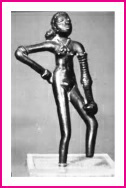Harappan civilization

Till 1920, the relics of the civilization were found only in the Indus valley region; therefore, it was known as the Indus civilization.
In 1920-21, the Harappan civilization was discovered in the excavations by D. R. Salini (at Harappa) and by R. D. Banerjee (at Mohenjo Daro).
The remains of the civilization were first noticed at Harappa, therefore it is also known as the Harappan civilization.
Geographical Facts
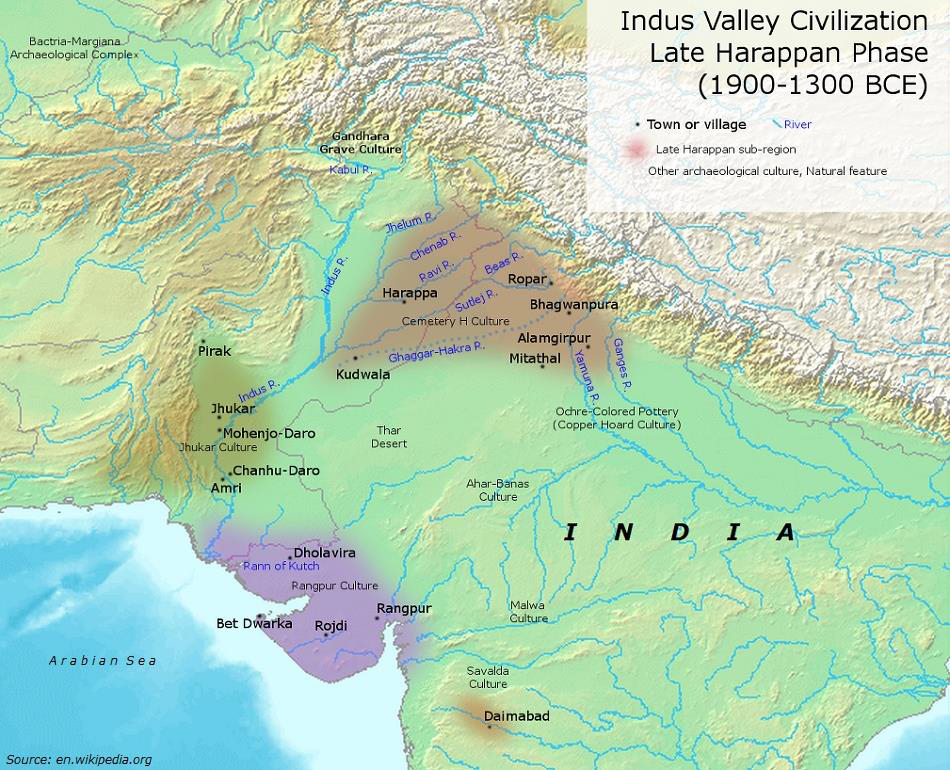
The 1,400 settlements of this civilization discovered so far are distributed over a very wide geographical area covering almost 1,600 km (east to west) and 1,400 km (north to south).
Harappan civilization extent starts from:
o Sutkagendor (Baluchistan) in the west to Alamgirpur (Meerut, Uttar Pradesh) in the east and
o Manda (Akhnoor District, Jammu and Kashmir) in the north to Daimabad (Ahmadnagar District, Maharashtra) in the south.
About 1,400 settlements of the Harappan culture are known from different parts of India. About 925 settlements sites are now in India and 475 are in Pakistan.
The total geographical stretch - about 1,250,000 sq. km , more than 20 times of the area of Egyptian , more than 12 times of the combined area of Egyptian and Mesopotamian civilizations.
o About 250 settlements were found in India beyond the Saraswati River system; a number of them were located in Gujarat, and a few in Maharashtra.
o The distribution pattern of settlements shows that the focus of Harappan civilization was not the Indus, but the Saraswati River and its tributaries, which flowed between the Indus and the Ganga. Therefore, few researchers prefer to call it as Saraswati civilization or Indus-Saraswati civilization
important sites of the Indus Valley civilisationHarappa in present Pakistan on the bank of River Ravi – 2 row of six granaries with big platform, stone symbol of lingam and yoni, mother goddess figure, wheat and barley in wooden mortar, dice, copper scale and mirror. Moreover, sculpture of dog chasing a deer in bronze metal, and a red sand stone male torso have been excavated. Mohenjo-daro in present Pakistan on the River Indus – the citadel, the great bath, the great granary, post cremation burial, sculpture of bearded priest, the famous bronze statue of the Dancing Girl and Pashupati seal. Dholavira in Gujarat – giant water reservoir, unique water harnessing system, stadium, dams and embankments, inscription comprising 10 large sized signs like an advertisement board. Lothal (Manchester of Indus Valley civilisation) in Gujarat – important site for naval trade, had a Dockyard, practice of burial of cremated remains, rice husk, fire altars, painted jar, modern day chess, terracotta figure of horse and ship, instruments for measuring 45, 90 and 180 degree angles, practice of burial of cremated remains. Rakhigarhi in Haryana is considered to be the largest site of Indus Valley civilization. Granary, cemetery, drains, terracotta bricks have been found. Ropar is located on the banks of Sutlej in Punjab, India – Dog buried with human oval pit burials, copper axe. Balathal and Kalibangan in Rajasthan – bangle factory, toy carts, bones of camel, decorated bricks, citadel and lower town, Fire altar. Surkotada in Gujarat – first actual remains of the horse bones. Banawali in Haryana on the dried-up Saraswati river – toy plough, barley grains, lapis lazuli, fire altars oval shaped settlement, only city with radial streets. Alamgirpur in Meerut, Uttar Pradesh on the banks of Yamuna – Eastern most site of IVC. Major findings are broken blade made of copper, ceramic items and Impression of a cloth on a trough. Mehrgarh in Pakistan, considered precursor to Indus Valley Civilisation, Pottery, copper tools have been found. |
Architecture in Harappan Civilisation
- Remarkable sense of town planning. The towns were laid out in a rectangular grid pattern. The roads ran in north-south and east-west direction and cut each other at right angles.
- Mainly three types of buildings have been found in the excavation sites – dwelling houses, public buildings and public baths. The Harappans used burnt mud bricks of standardised dimensions for the purpose of construction. Many layers of well-baked brick were laid out and then joined together using gypsum mortar.
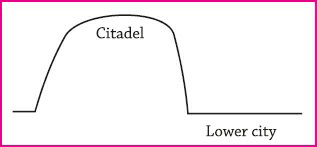 Citadel and lower city
Citadel and lower city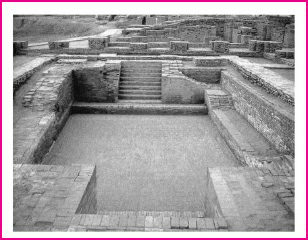 Great bath at Mohenjo-daro
Great bath at Mohenjo-daro
Seals
- primarily used for commercial purposes and helped in communication.
- Discovery of various seals in Mesopotamia and various sites such as Lothal points to the fact that seals were extensively used for trade.
- Some seals with a hole on them have been found on dead bodies.
- Seals with symbol similar to ‘Swastika’ design have also been found. Example: Pashupati seal, Unicorn seal
Pashupati Seal:
- A steatite seal discovered at Mohenjo-daro depicts a human figure or a deity seating cross-legged.
- The figure, referred to as Pashupati wears a three-horned headgear and is surrounded by animals.
- An elephant and a tiger are there on the left side of the figure while a rhinoceros and a buffalo are seen on the right side.
- Two antelopes are shown below the seat of the figure.
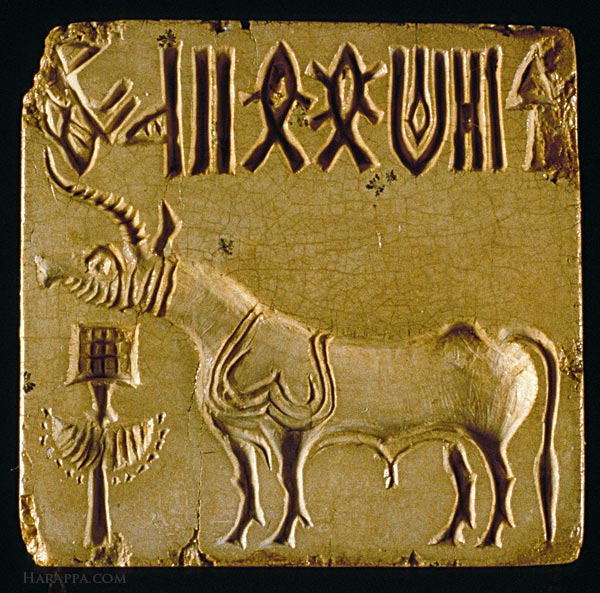
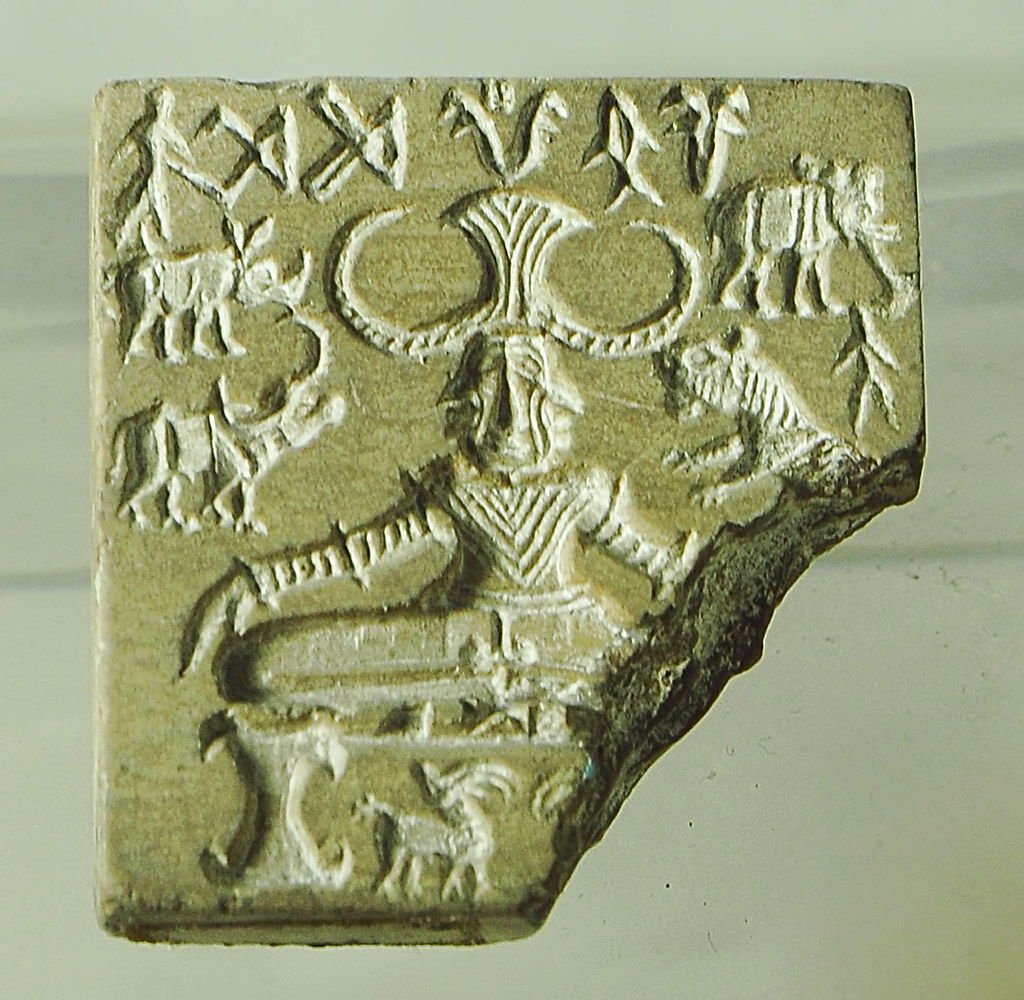
Bronze figures:
- “lost wax technique” or “Cire Perdue”.
- Example: Bronze dancing girl of Mohenjo-daro, bronze bull of Kalibangan, etc.
The Dancing Girl of MohanjodaroThe Dancing Girl is the world’s oldest bronze sculpture. Found in Mohenjo-daro, this four inch figure depicts a naked girl wearing only ornaments, which include bangles in the left arm, and amulet and bracelet on the right arm. She stands in a ‘tribhanga’ dancing posture with the right hand on her hip. |
Terracotta
- Terracotta refers to the use of fire baked clay for making sculptures. Compared to the bronze figures
- They were made using pinching method and have been found mostly in the sites of Gujarat and Kalibangan.
- toys, animal figures, miniature carts and wheels, etc.
- Example: Mother Goddess, mask of horned deity, etc.
The mother goddess figures have been found in many Indus sites, which highlights its importance.
It is a crude figure of a standing female adorned with necklaces hanging over prominent breasts. 
She wears a loincloth and a girdle. She also wears a fan-shaped headgear. The facial features are also
shown very crudely and lacks finesse. She was probably worshipped for prosperity.
She might also have been a goddess of fertility cults.

